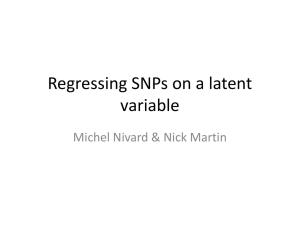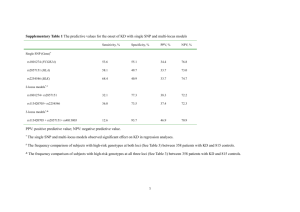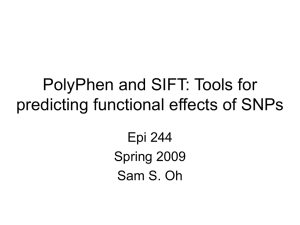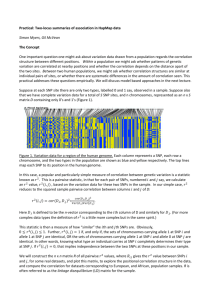gcbb12280-sup-0009-SuppInfo
advertisement
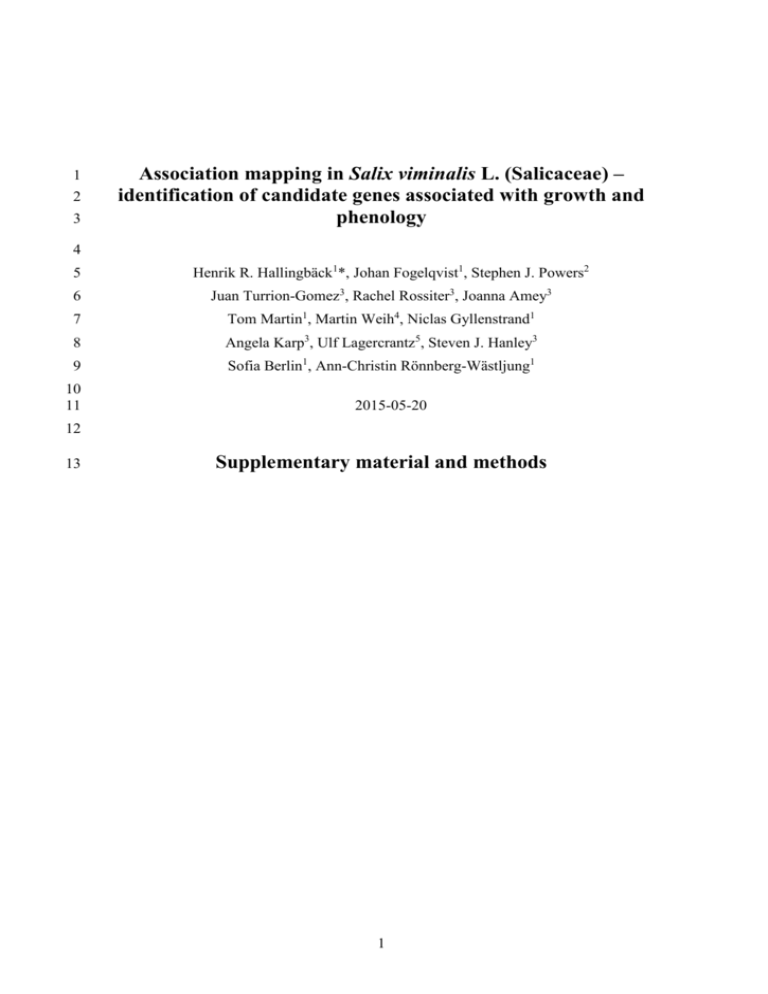
1
2
3
Association mapping in Salix viminalis L. (Salicaceae) –
identification of candidate genes associated with growth and
phenology
4
5
Henrik R. Hallingbäck1*, Johan Fogelqvist1, Stephen J. Powers2
6
Juan Turrion-Gomez3, Rachel Rossiter3, Joanna Amey3
7
Tom Martin1, Martin Weih4, Niclas Gyllenstrand1
8
Angela Karp3, Ulf Lagercrantz5, Steven J. Hanley3
9
Sofia Berlin1, Ann-Christin Rönnberg-Wästljung1
10
11
2015-05-20
12
13
Supplementary material and methods
1
14
A. Salix reference sequence assembly
15
Salix reference sequences for the amplified loci were constructed as follows: First the
16
quality filtered (ConDeTri v2.0, hq=30, minL=70, Smeds & Küstner, 2011) Illumina reads
17
were mapped (Mosaik v1.1 -act 35 -bw 25 -mm 18 -hs 15, Lee et al., 2014) to the poplar
18
reference sequence at the corresponding loci. Duplicated reads were removed (GATK
19
MarkDuplicates v1.104418, McKenna et al., 2010) and variants (SNPs and indels) were
20
subsequently called using Samtools mpileup and vcfutils.pl varFilter, v0.1.12 at default
21
settings (Li et al., 2009). Variants exhibiting allele frequencies above 0.8 across samples
22
were incorporated into the poplar reference whereupon the reads were remapped to this
23
reference. The process was repeated until no new variant could be called. Regions of the
24
processed poplar reference with a high coverage of Illumina reads (>20% median non-zero
25
overage, minimum 90 bp) were retained.
26
Next a de novo assembly was made for each sample, using Velvet v1.04 with K=31
27
again only using quality filtered reads (ConDeTri v2.0, hq=30, minL=70, Smeds &
28
Küstner, 2011). These de novo contigs were then mapped to the poplar reference (including
29
incorporated variants) uding NCBI Blast (v2.2.21, e-value cutoff at 10-5, Altschul et al.,
30
1990) and the best match for each contig was recorded. For each locus and Salix accession,
31
de novo sequences with Blast matches and regions of high coverage were assembled with
32
PHRAP (www.phrap.org). The resulting contigs for each locus were aligned (kalign v2.04,
33
default settings, Lassmann & Sonnhammer, 2005) and were subjected to manual
34
inspection/adjustment as deemed necessary. Consensus sequences were thus generated
35
using the most common base at each site and were furthermore compared to known
2
36
paralogous loci in poplar in order to verify that paralogous loci hadn’t been amplified by
37
mistake. For each locus we also verified that primer sequences used for sequence
38
amplification were consistently present at the ends of the sequence. Finally SNPs were
39
called using the same steps as described for the poplar reference approach.
40
B. Significance testing of structure model terms
41
To address the possibility that either of the Fq or Zu terms were superfluous, these were
42
subjected to significance testing for each trait omitting the individual SNP term. First, the
43
random term Zu was examined by testing log-likelihood ratio between the full (Fq+Zu)
44
2
and reduced (Fq) models against the 𝜒𝑑𝑓=1
distribution and if non-significant (p>0.05) it
45
was thereafter omitted. Subsequently the fixed term Fq was subjected to the Wald-F test
46
implemented in ASReml and TASSEL and if non-significant (p>0.05) it was omitted. This
47
sequential order of tests was imposed because tests of fixed terms usually assume that
48
random terms are properly treated a priori (Welham & Thompson, 1997). For the traits
49
where the tests indicated a reduced model to be preferable (see Table S2), we used that
50
model to redo the association mapping analysis. The results from reduced model analyses
51
were however very similar to those of the full model and for the sake of consistency, only
52
the full model association results are further treated in this study.
53
C. Multivariate analyses
54
In order to formally assess the occurence of SNP associations that were consistent across
55
sites and assessment years (variates), and also SNP associations significantly interacting
56
with sites and years implying G×E-interactions, multivariate forms of the univariate model
3
57
in eq. 3 were formulated. The multivariate approach taken here is very similar to the
58
multi-trait mixed models initially developed for pedigree based genetic analysis (e.g. Wei
59
& Borralho 1998) but later expanded to accomodate association mapping by Korte et al.
60
(2012). As an example, the bivariate form applied for the analysis of accession estimators
61
yes1 and yes2 for variates 1 and 2 respectively is shown below:
62
63
64
𝐲𝑒𝑠1
𝐅
[𝐲 ] = [
𝟎
𝑒𝑠2
𝟎 𝐪1
𝐒
𝐒
𝐙
] [𝐪 ] + [ ] 𝐠 𝑐 + [ ] 𝐠 𝑖 + [
𝐅
𝐒
𝟎
𝟎
2
𝐞𝑒𝑠1
𝟎 𝐮1
] [𝐮 ] + [𝐞 ]
𝐙
2
𝑒𝑠2
(C1)
Most of the model terms are merely multivariate extensions of eq. 3, but SNP
65
genotype effects were here separated into the gc-term which signifies consistent or common
66
SNP genotype effects across sites and years (variates), while the gi-term signifies SNP
67
genotype effects that interact with sites and years. The model is easy to expand further to
68
accomodate more than two variates. All effects were considered to be statistically
69
independent except for the random terms whose variances were assumed to be internally
70
structured as:
71
2
𝜎𝑒,𝑒𝑠1
𝐞𝑒𝑠1
𝜎𝐴12
]
⊗
𝐊
and
𝑉𝑎𝑟
[
]
=
[
2
𝐞𝑒𝑠2
𝜎𝐴2
𝜎𝑒,𝑒𝑠12
72
𝐮1
𝜎2
𝑉𝑎𝑟 [𝐮 ] = 2 [ 𝐴1
2
𝜎𝐴12
73
2
2
2
2
where 𝜎𝐴1
, 𝜎𝐴2
, 𝜎𝑒,𝑒𝑠1
and 𝜎𝑒,𝑒𝑠2
are the additive genetic chip and residual variances for
74
variates 1 and 2 respectively; σA12 and σe,es12 are the additive genetic chip and residual
75
covariances between variates 1 and 2; ⊗ is the Kronecker matrix product and I is an
76
identity matrix.
4
𝜎𝑒,𝑒𝑠12
]⊗𝐈
2
𝜎𝑒,𝑒𝑠2
(C2)
77
Joint multivariate association analyses using this model were performed for all
78
traits that were assessed more than once (several years or sites, Table 1). Thus, bud burst
79
was analysed using a model with five variates, leaf senescence with three variates and for
80
each of the biomass traits (Nsh, MeanD, MaxD, SumD) only two variates. Analyses were
81
then conducted using ASReml (Gilmour et al., 2009) in a manner similar to that of the
82
univariate analyses. However, in similarity to the study of Korte et al. (2012) the
83
significance testing for potential SNP-trait associations had to be performed in two
84
separate steps. First, in order to obtain a general unspecific support for SNP-trait
85
associations, Wald-F tests were performed for each SNP and trait for both gc and gi jointly
86
against the null hypothesis of no association at all (gc=0 and gi=0). In this scan, the same
87
type of multiple testing correction was applied as for the univariate analyses (Storey &
88
Tibshirani, 2003). In the second step, those SNPs showing a general suggestive/significant
89
association (FDR-q<0.2) to a trait were subjected to two additional Walf-F tests. The
90
significance of the common SNP effect (gc) was tested in the absence of any interaction
91
SNP effects (setting gi=0) and subsequently the interaction SNP effect (gi) was tested in the
92
presence of gc. As the two latter tests are sensitive to variate scale differences, all variates
93
were transformed to a common accession variance by dividing all accession estimators by
94
σc prior to multivariate analysis (see eq. 1 and 2). Moreover, as the common and interaction
95
SNP tests only were performed on a subset of SNPs, a multiple testing correction
96
procedure such as that used for the general test was not meaningful. However, a threshold
97
of suggestive significance was still arbitrarily set at p<0.001 which is well comparable to
98
the FDR-q<0.2 threshold used for many of the other analyses performed in this study.
5
99
Apart from testing common and interaction effects of SNP-trait associations per se,
100
the overall impact of scale independent G×E-interactions on trait variation was tested by
101
estimating accession correlations between variates adjusted for population structure
102
(Burdon, 1977). This was done by applying the bivariate model shown in eq. C1 to trait
103
pairs (variates) but excluding all terms pertaining to SNP genotypic effects (gc and gi).
104
2
2
Accession variances for each trait 1 and 2 (𝜎𝑠1
and 𝜎𝑠2
) and covariances between them
105
(σs12) were then calculated as the sum of the corresponding chip additive and residual
106
2
2
2
(co)variance components respectively (e.g. 𝜎𝑠1
= 𝜎𝐴1
+ 𝜎𝑒,𝑒𝑠1
) and accession correlations
107
were calculated as 𝑟𝑠 = 𝜎𝑠12 ⁄(𝜎𝑠1 𝜎𝑠2 ).
108
D. Adjusting for threshold selection bias by simulation
109
In order to assess and compensate for the threshold selection bias and to assess the
110
statistical power for the associations, simulated accession estimator data (ysi) were
111
generated and designed to mimic the presence of artificial SNP effects (gsi) with a
112
2
prespecified and common percentage of explained variance (𝑅𝑝𝑠
). Subsequently this data
113
was subjected to regular univariate association mapping analysis (eq. 3) with the objective
114
2
of re-estimating the ratio of variance explained (𝑅𝑠𝑖
) regardless of the prior knowledge.
115
The average R2-estimate of the significantly associated portions of these simulated data
116
2
analyses (𝑅̃𝑠𝑖
) was then observed to be substantially and systematically larger
117
(overestimated) in comparison to the average R2-estimate over all simulations (𝑅𝑠𝑖 ) which
118
2
is free from selection threshold bias. Furthermore, because 𝑅̃𝑠𝑖
increases with both rising
119
2
𝑅𝑝𝑠
and 𝑅𝑠𝑖 it was possible to adjust for the selection threshold bias by finding an 𝑅𝑠𝑖
2
2
2
6
120
which minimised the difference between the original analysis and simulated analysis ratios
121
2
of explained variance (𝑚𝑖𝑛|𝑅 2 − 𝑅̃𝑠𝑖
|, see Allison et al., 2002 and Ingvarsson et al., 2008).
122
Series of simulations were generated for each trait and field trial separately, and for each
123
simulation one of the 1233 investigated SNPs was randomly chosen. Simulated accession
124
estimators were generated as:
125
126
̂ + 𝐒𝐠 𝑠𝑖 + 𝐙𝐮
𝐲𝑠𝑖 = 𝐅𝐪
̂ + 𝐞𝑠𝑖
(D1)
127
̂ and 𝐮
where 𝐪
̂ are effect estimates obtained from the ASReml association analysis
128
2
outputs (eq. 3) of the chosen SNP. Residuals esi were randomly drawn from the 𝑁(0, 𝜎𝑒,𝑒𝑠
)
129
2
distribution also using the 𝜎𝑒,𝑒𝑠
estimate of the original association analysis. To simplify
130
the artificial generation of gsi, only additive SNP effects were considered
131
2
(𝐠 𝑠𝑖 = [1 0 − 1]𝑇 𝑔𝐴𝐴 ). SNP effect generation given a specified 𝑅𝑝𝑠
could thus be
132
performed by determining gAA as:
133
134
𝑔𝐴𝐴 = √(1−𝑅2
2 𝜎2
𝑅𝑝𝑠
𝑦−𝑆𝑔
2
𝑝𝑠 )(𝑃𝐴𝐴 +𝑃𝑎𝑎 −(𝑃𝐴𝐴 −𝑃𝑎𝑎 ) )
(D2)
135
2
where 𝜎𝑦−𝑆𝑔
is the estimated variance of the sum of all effects present in eq. D1 except for
136
Sgsi itself and where PAA and Paa are the frequencies of the homozygote genotypes in the
137
sample for the chosen SNP (see also section E). By extensive simulations, Allison et al.
138
(2002) showed that in case the assumption of pure additive effects was violated, the
139
method used here may adjust R2 insufficiently. However the same results also suggested
7
140
that the remaining threshold selection bias would be minor given that the true effects
141
themselves were small and that adjustments always yielded less biased R2 than unadjusted
142
estimates even in case SNP effects were dominant/recessive rather than additive.
143
2
Subsequently, series of simulated accession predictors were generated for 𝑅𝑝𝑠
144
values in the range 0 to 10% with a resolution of 0.1%. Association mapping analyses
145
using the full model (eq. 3) were performed for these series. Assessment of significance
146
was performed using Wald-F p thresholds (pth) that would closely correspond to the FDR-q
147
thresholds applied in the original analysis (qth at 0.05 or 0.2). Given the relationship
148
between p and q shown by Storey & Tibshirani (2003), pth thresholds were calculated for
149
each trait and field trial as:
150
𝑝𝑡ℎ = {
151
𝑞𝑡ℎ 𝜋𝑡ℎ ⁄𝜋0 if 𝜋𝑡ℎ > 0
𝑞𝑡ℎ ⁄𝑛𝑡𝑜𝑡 if 𝜋𝑡ℎ = 0
(D3)
152
where πth is the proportion of analysed SNPs counted as significantly (or suggestively)
153
associated in the original analysis, π0 is the estimated proportion of true null hypotheses in
154
the original analysis, and ntot is the total number of SNPs analysed. Using these thresholds
155
it was then possible to select subsets of simulated data analyses in order to manually find
156
2
the 𝑅𝑠𝑖 that would minimise |𝑅 2 − 𝑅̃𝑠𝑖
|. Such searches were performed for all suggestive
157
or significant associations and the best 𝑅𝑠𝑖 -value found for each association was assigned
158
2
to be the treshold bias adjusted ratio of variance explained (𝑅𝑎𝑑𝑗
). Likewise, as variances
159
and their ratios are based on squares of effects, it was also possible to calculate
160
bias-adjusted SNP effects by using the square root of the adjusted-to-biased quotients:
2
2
8
𝑅𝑎𝑑𝑗
161
𝐠̂ 𝑎𝑑𝑗 =
162
2
2
biased 𝑅̃𝑠𝑖
estimate was based on a sample of at least 100 𝑅𝑠𝑖
estimates of significant
163
associations. Finally, the statistical power for finding SNP-trait associations at FDR-q=0.2
164
was estimated as the proportion of simulations for which p<pth for each trait and potential
165
2
𝑅𝑎𝑑𝑗
estimate (i.e. 𝑅𝑠𝑖 ).
166
E. Derivation of 𝑹𝟐𝒑𝒔
167
The prespecified variance ratio of variance explained by an artificial SNP association
168
2
effect (𝑅𝑝𝑠
) can be expanded as:
𝑅
𝐠̂. In order to obtain stable and convergent results it was required that the
2
169
2
𝑅𝑝𝑠
=
170
2
𝜎𝑝𝑠
(E1)
2 +𝜎 2
𝜎𝑝𝑠
𝑦−𝑆𝑔
171
2
2
where 𝜎𝑝𝑠
is the variance of the artificial SNP association while 𝜎𝑦−𝑆𝑔
is the variance of
172
̂ + 𝐙𝐮
𝐅𝐪
̂ + 𝐞𝑠𝑖 . The variance of the artificial SNP association is in turn expanded as:
173
174
2
𝜎𝑝𝑠
= 𝑃𝐴𝐴 (𝑔𝐴𝐴 − 𝑔̅ )2 + 𝑃𝐴𝑎 (𝑔𝐴𝑎 − 𝑔̅ )2 + 𝑃𝑎𝑎 (𝑔𝑎𝑎 − 𝑔̅ )2
(E2)
175
where PAA, PAa and Paa are the frequencies and gAA, gAa and gaa are the effects of the SNP
176
genotypes AA, Aa and aa respectively, and where 𝑔̅ is the overall mean effect across
177
genotypes:
178
𝑔̅ = 𝑃𝐴𝐴 𝑔𝐴𝐴 + 𝑃𝐴𝑎 𝑔𝐴𝑎 + 𝑃𝑎𝑎 𝑔𝑎𝑎
9
(E3)
179
Substituting 𝑔̅ in eq. E2 with E3 assuming that artificial association effects are
180
strictly additive (gaa=- gAA and gAa=0) and noting that PAa=1- PAA- Paa, the expression for
181
2
𝜎𝑝𝑠
may then be simplified to:
182
183
184
185
2
2
𝜎𝑝𝑠
= 𝑔𝐴𝐴
(𝑃𝐴𝐴 + 𝑃𝑎𝑎 − (𝑃𝐴𝐴 − 𝑃𝑎𝑎 )2 )
(E4)
2
By solving gAA out of eq. E4 and 𝜎𝑝𝑠
out of eq. E1, the artificial SNP association effects
2
2
are determined in terms of 𝑅𝑝𝑠
and 𝜎𝑦−𝑆𝑔
as:
186
187
188
189
𝑔𝐴𝐴 = √(1−𝑅2
2 𝜎2
𝑅𝑝𝑠
𝑦−𝑆𝑔
2
𝑝𝑠 )(𝑃𝐴𝐴 +𝑃𝑎𝑎 −(𝑃𝐴𝐴 −𝑃𝑎𝑎 ) )
Notably, as this expression is dependent on genotype rather than allele frequencies
it does not assume the studied population to conform to Hardy-Weinberg equilibrium.
10
190
References
191
Allison DB, Fernandez JR, Moonseong H, Zhu S, Etzel C, Beasley TM, Amos CI (2002)
192
Bias in Estimates of Quantitative-Trait-Locus Effect in Genome Scans:
193
Demonstration of the Phenomenon and a Method-of-Moments Procedure for
194
Reducing Bias. American Journal of Human Genetics, 70, 575–585.
195
196
197
198
199
200
201
Altschul SF, Gish W, Miller W, Myers EW, Lipman DJ (1990) Basic Local Alignment
Search Tool. Journal of Molecular Biology, 215, 403–410.
Burdon RD (1977) Genetic correlation as a Concept for Studying Genotype-Environment
Interaction in Forest Tree Breeding. Silvae Genetica, 26, 168–175.
Gilmour AR, Gogel BJ, Cullis BR, Thompson R (2009) ASReml User Guide, VSN
International Ltd, Hemel Hempstead, HP1 1ES, UK, 3rd ed.
Ingvarsson PK, Garcia MV, Luquez V, Hall D, Jansson S (2008) Nucleotide
202
Polymorphism and Phenotypic Associations Within and Around the phytochrome B2
203
Locus in European Aspen (Populus tremula, Salicaceae). Genetics, 178, 2217–2226.
204
Korte A, Vilhjálmsson BJ, Segura V, Platt A, Long Q, Nordborg M (2012) A mixed-model
205
approach for genome-wide association studies of correlated traits in structured
206
populations. Nature Genetics, 44, 1066–1071.
207
208
209
Lassmann T, Sonnhammer ELL (2005) Kalign – an accurate and fast multiple sequence
alignment algorithm. BMC Bioinformatics, 6, 298.
Lee WP, Stromberg MP, Ward A, Stewart C, Garrison EP, Marth GT (2014) MOSAIK: a
210
hash-based algorithm for accurate next-generation sequencing short-read mapping.
211
PloS One, 9, e906581.
11
212
213
214
Li H, Handsaker B, Wysoker A, et al. (2009) The Sequence Alignment/Map format and
SAMtools. Bioinformatics, 25, 2078–2079.
McKenna A, Hanna M, Banks E, et al. (2010) The genome analysis toolkit: A MapReduce
215
framework for analyzing next-generation DNA sequencing data. Genome Research,
216
20, 1297–1303.
217
218
219
Smeds L, Küstner A (2011) ConDeTri – A Content Dependent Read Trimmer for Illumina
Data. PLoS One, 6, e26314.
Storey JD, Tibshirani R (2003) Statistical significance for genomewide studies.
220
Proceedings of the National Academy of Sciences of the United States of America,
221
100, 9440–9445.
222
Wei X, Borralho NMG (1998) Use of individual tree mixed models to account for
223
mortality and selective thinning when estimating base population genetic parameters.
224
Forest Science, 44, 246–253.
225
Welham SJ, Thompson R (1997) Likelihood Ratio Test for Fixed Model Terms Using
226
Residual Maximum Likelihood. Journal of the Royal Statistical Society Series B
227
(Methodological), 59, 701–714.
12




